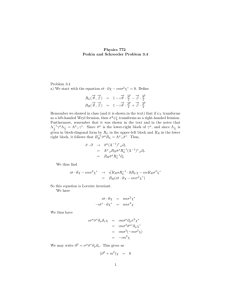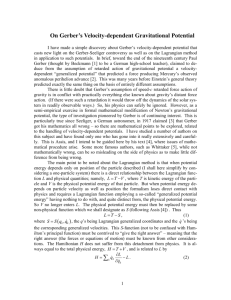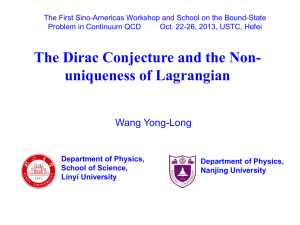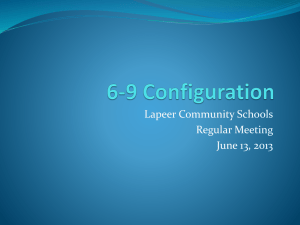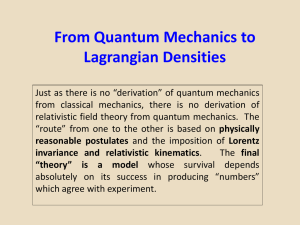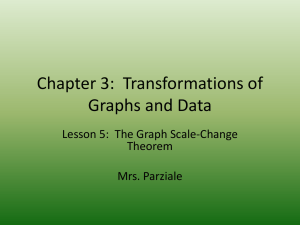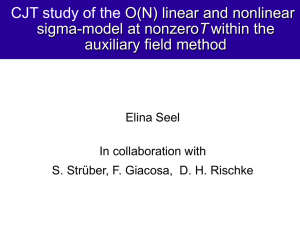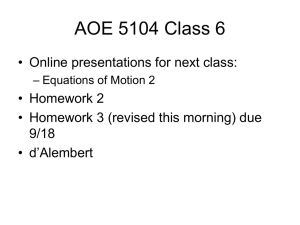t - Springer
advertisement
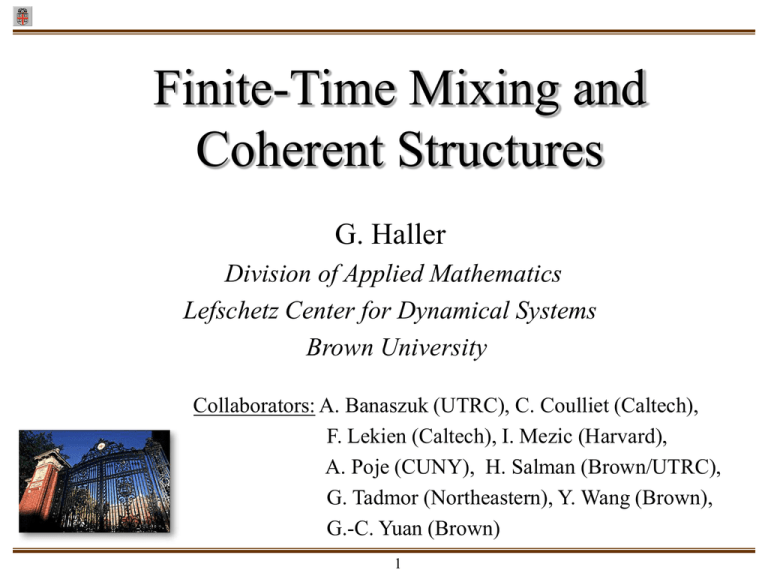
Finite-Time Mixing and
Coherent Structures
G. Haller
Division of Applied Mathematics
Lefschetz Center for Dynamical Systems
Brown University
Collaborators: A. Banaszuk (UTRC), C. Coulliet (Caltech),
F. Lekien (Caltech), I. Mezic (Harvard),
A. Poje (CUNY), H. Salman (Brown/UTRC),
G. Tadmor (Northeastern), Y. Wang (Brown),
G.-C. Yuan (Brown)
1
Fundamental observation: In 2D turbulence coherent structures emerge
What is a coherent structure?
• region of concentrated vorticity that retains its
structure for longer times (Provenzale [1999])
• energetically dominant recurrent pattern
(Holmes, Lumley, and Berkooz [1996])
• set of fluid particles with distinguished
statistical properties
(Elhmaidi, Provenzale, and Babiano [1993])
• larger eddy of a turbulent flow
(Tritton [1987])
• dynamical systems: no conclusive answer for
turbulent flows - spatio-temporal complexity
- finite-time nature
2
Absolute dispersion plot
for the 2D QG equations
A Lagrangian Approach to Coherent Structures
Particle mixing in 2D turbulence
stretching: fluid blob opens up along
a material line
repelling material line
folding: fluid blob spreads out along
a material line
attracting material line
swirling/shearing: fluid blob
encircled/enclosed by neutral
material lines
Approach coherent structures through material stability
3
Stability of material lines
l (t ) is repelling over the time interval Iu if vectors normal
to it grow in arbitrarily short times within
Iu.
F (x0 ) N (x0 )
h
h
F (x0 ) :
l (t0 )
N (x 0 )
x(t )
l (t )
deformation field
N (x0 ) :
unit normal
Attracting material line: repelling in backward time
4
Definitions of hyperbolic Lagrangian structures:
A stretch line is a material line that is repelling for locally
the longest/shortest time in the flow
openflow: Tu is locally maximal
near wall(no- slip) : Tu is locallyminimal
A fold line is a material line that is attracting for locally
the longest/shortest time in the flow
5
How do we find stretch and fold lines lines from data?
Numerical approaches:
Miller, Jones, Rogerson & Pratt [Physica D, 110, 1997]: “straddle” near instantaneous
saddle-type stagnation points
of the velocity field
Bowman [preprint, 1999], Winkler [thesis, Brown, 2000]: use relative dispersion plots
Poje, Haller, & Mezic [Phys. Fluids A,11, 1999]: use Lagrangian mean velocity plots
Couillette & Wiggins [Nonlin. Proc. Geophys., 8, 2001]: straddling near boundary points
Joseph & Legras [J. Atm. Sci., submitted, 2000]: finite-size Lyapunov exponent plots
…
6
How do we find stretch and fold lines lines from data?
Analytic view: stability of a fluid trajectory x(t) is governed by
ξ u(x(t ), t )ξ O ( ξ 2 ).
Linear part is solved by:
ξ(t ) F (x0 )ξ 0 .
t
Simplest approach: look for stretch lines as places of maximal stretching:
Theorem (necessary criterion): Stretch lines at t=0 maximize the scalar field
t (x0 ) max Ft (x0 )* Ft (x0 )
(DLE algorithm, Haller [Physica D, 149, 2001])
7
Example 1: velocity data 2D geophysical turbulence
q
, q 4 4 q F ,
t
u 0,
• q
2
•
`is the potential vorticity
2
10 is the scaled inverse of the Rossby
deformation radius
•
4 5 107 denotes the coefficient of
hyperviscosity
• x [0,2 ] [0,2 ]
8
QG equations in 2D.
•pseudo-spectral code of A. Provenzale
•particle tracking with VFTOOL of P. Miller
by G-C. Yuan
Eulerian view on coherent structures: potential vorticity gradient
Contour plot of | q |
Contour plot of q
9
Eulerian view on coherent structures: Okubo-Weiss partition
Elliptic regions:
Hyperbolic regions:
Contour plot of q
22 s 22
s
s 2 ( xux yu y )2 (Y ux xu y )2 ; 2 ( xu y yux )2
10
Stretch lines from DLE analysis
Stretch lines at t=50
Contour plot of q at t=50
(= locally strongest finite-time stable manifolds)
11
Fold lines from DLE analysis
Fold lines at t=50
Contour plot of q at t=50
(= locally strongest finite-time unstable manifolds)
12
Example 2: HF radar data from Monterey Bay
Image by Chad Coulliet & Francois Lekien (MANGEN, http://transport.caltech.edu)
DLE analysis of surface velocity
log t ( x 0 )
maxlog t ( x 0 )
Data by Jeff Paduan,
Naval Postgraduate School
• Lagrangian separation point
• instantaneous stagnation point
13
Example 3: Experiments by Greg Voth and Jerry Gollub (Haverford)
Mixing of dye in charged fluid, forced periodically in time by magnets
Dye
Dye+fold lines
14
Dye+stretch lines
Room for improvement:
• Occasional slow convergence
• Shear gradients show up as stretch lines (finite time!)
• Nonhyperbolic Lagrangian structures? (jets, vortex cores,…)
• What do we learn?
What is missing? The Eulerian physics
Question:
What is the objective Eulerian signature of intense Lagrangian
mixing or non-mixing?
Available frame-dependent results: Haller and Poje [Physica D, 119, 1998],
Haller and Yuan [Physica D, 147, 2000], Lapeyre, Hua, and Legras [J. Atm. Sci., submitted, 2000],
Haller [Physica D, 149, 2001. (3D flows)]
15
Consider
S(x, t ) 12 u(x, t ) u(x, t )* ,
M S 2Su,
where M is the strain acceleration tensor (Rivlin derivative of S)
Notation:
M |Z positive def .
M |Z positive semidef.
Z(x,t) : directions of zero strain
M |Z : restriction of M to Z
Definitions:
M |Z indefinite
S0
Hyperbolic region: H (t ) ={M |Z pos.def.}
P (t ) ={M |Z pos. semidef.}
Parabolic region:
E(t ) ={M |Z indef. or S=0}
Elliptic region:
True instantaneous flow geometry
16
EPH partition of 2D turbulence
over a finite time interval I
Fully objective
picture, i.e., invariant
under time-dependent
rotations and translations
17
MAIN RESULTS (Haller [Phys. Fluids A., 2001,to appear])
Theorem 1 (Sufficient cond. for Lagrangian hyperbolicity)
Assume that x(t) remains in H (t ) over the time interval I.
Then x(t) is contained in a hyperbolic material line over I.
Theorem 2 (Necessary cond. for Lagrangian hyperbolicity)
Assume that x(t) is contained in a hyperbolic material line over I.
Then x(t) can • intersect P (t ) only at discreet time instances
• stay in E(t ) only for short enough time intervals J
satisfying
, M
J S dt
Theorem 3 (Sufficient cond. for Lagrangian ellipticity)
Assume that x(t) remains in E(t ) over I and
, M
, M
local eddy
dt
2
I S
turnover time!
S
Then x(t) is contained in an elliptic material line over I.
18
Example 1: Lagrangian coherent structures in barotropic turbulence simulations
Time spent in E(t )
19
Fastest converging:
Plot of (t , x0 )
| S(x(t ), t ) |,
0,
t=60
Earlier result from DLE
x(t ) H (t ),
x(t ) E(t ),
local flux!
t=85
Local minimum curves are stretch
lines (finite-time stable manifolds)
20
Example 2: HF radar data from Monterey Bay
Image by Chad Coulliet & Francois Lekien (MANGEN, http://transport.caltech.edu)
(t, x0 )
| S(x(t ), t ) |,
0,
x(t ) H (t ),
x(t ) E(t ),
Data by Jeff Paduan,
Naval Postgraduate School
Filtering by Bruce Lipphardt
& Denny Kirwan (U. of Delaware)
21
How are Lagrangian coherent structures
related to the governing equations?
Answer for 2D, incompressible Navier-Stokes flows:
( Haller [Phys. Fluids A, 2001, to appear] )
Theorem (Sufficient dynamic condition for Lagrangian hyperbolicity)
Consider the time-dependent physical region defined by
2
s 1 max ( p' ' ) max ( 2S) 12 max f f * .
2
All trajectories in the above region are contained in finitetime hyperbolic material lines .
22
Towards understanding Lagrangian structures in 3D flows
Hyperbolic Lagrangian
structures fall into
10 categories
Existing analytic results in 3D:
• DLE algorithm extends directly
• frame-dependent approach has been
extended (Haller [Physica D, 149, 2001])
23
An example: Lagrangian coherent structures in the ABC flow
x A sin z C cos y,
y B sin x A cos z,
z C sin y B cos x.
Henon [1966], Dombre et al. [1986]:
Poincare map for A=1, B= 2 / 3 , C= 1 / 3
1200 iterations used
3D DLE analysis
24
Some open problems (work in progress):
• Survival of Lagrangian structures (obtained from filtered data)
in the “true” velocity field
• Lagrangian structures in 3D (objective approach)
• Dynamic mixing criteria for other fluids equations and different
constitutive laws
• Relevance for mixing of diffusive/active tracers
25

